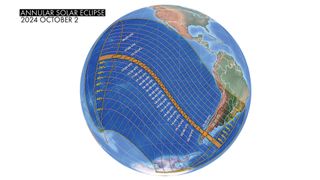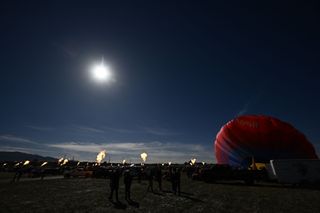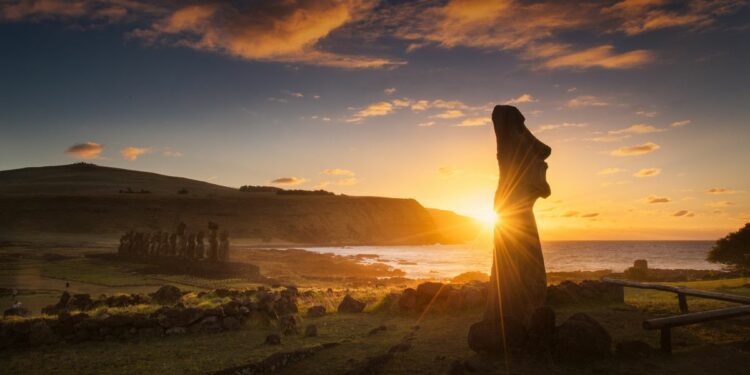Coming off the excitement of last April’s Great North American Eclipse of the sun, many have asked when the next solar eclipse will take place. The answer to that question is Tuesday, Oct. 2, when an annular eclipse takes place.
This is the type of solar eclipse where the moon is a little too distant from Earth to cover the sun completely, leaving a ring of sunlight shining around the moon’s silhouette; think of it as a “penny on nickel effect” with the penny representing the moon and the nickel the sun.
You may recall that last year, on Oct. 14 just such an eclipse swept across parts of the western and southern United States, as well as the Yucatan Peninsula of Mexico, Central America, southern Colombia and northern Brazil. Millions of people who lived within the path of annularity were able to watch (weather conditions permitting) as the sun morphed into a spectacular “ring of fire” for more than 5 minutes.
But for this upcoming annular solar eclipse on Oct. 2, things are going to be quite different. Unlike last year, where the path of the annular phase of the eclipse passed over many accessible population centers, to catch a view of this year’s solar ring will prove to be quite a bit of a challenge.
That’s because about 95 percent of the eclipse path will pass over open ocean waters.
Eclipse Predictions by Fred Espenak, www.EclipseWise.com (Image credit: Eclipse Predictions by Fred Espenak, www.EclipseWise.com)A track over Oceania
The path of the eclipse producing this “ring of fire” effect, will begin at local sunrise at a spot over the central Pacific Ocean just to the north of the equator, about 1,000 miles (1,600 km) southwest of Honolulu.
Shortly thereafter, the moon’s shadow will sweep first east, then in a southeast direction, across the equator and into the South Pacific Ocean, initially passing north of the island nation of Kiribati, then northeast of French Polynesia and the Pitcairn Islands. At the point of greatest eclipse, the annular phase will last for 7 minutes 24 seconds at an altitude of 69-degrees. Here, the eclipse path is 165 miles (265 km) wide.
Still, there will be thousands of individuals who are hoping to get a view of the ringed sun from perhaps one of the most isolated and remote spots on the face of the earth: the legendary and mystical Easter Island.

A map of the Oct. 2, 2024, annular solar eclipse. (Image credit: Michael Zeiler GreatAmericanEclipse.com)Fortuitously positioned
Easter Island, also known as Rapa Nui or Isla de Pascua, is a special territory of Chile. It is a breathtaking open-air museum and UNESCO World Heritage Site with much of the island protected within the Rapa Nui National Park. Fortuitously, it is also positioned almost directly within the path of the Moon’s shadow on Sunday affording both natives and tourists the opportunity to witness a total solar eclipse.
The name “Easter Island” was given by the island’s first recorded European visitor, the Dutch explorer Jacob Roggeveen, who encountered it on Easter Sunday, April 5, 1722, while searching for Davis or David’s island. The island’s official Spanish name, Isla de Pascua, is Spanish for “Easter Island.” It is 2,200 miles (3,600 km) west of continental Chile and 1,290 miles (2,075 km) east of the Pitcairn Islands. Sala y Gómez, 260 miles (415 km) to the east, is closer but uninhabited. It is directly due south of Salt Lake City and directly due east of Brisbane, Australia; it is the easternmost and almost the southernmost island of the South Pacific.
Approximately 1,200 or 1,300 years ago a double-hulled canoe filled with seafarers from a distant culture landed at Easter Island. Over the centuries that followed a remarkable society developed in isolation on the island. For reasons still unknown they began carving giant statues out of volcanic rock. These enormous monuments, known as “moai,” are some of the most incredible ancient relics ever discovered. At least 288 of these once stood upon massive stone platforms called ahu. There are some 250 of these ahu platforms spaced approximately one-half mile apart and they create an almost unbroken line around the perimeter of the island.

Sunrise in Tongariki, Rapa Nui, Easter Island. (Image credit: David Rius & Núria Tuca/Getty Images)
Another 600 moai statues, in various stages of completion, are scattered around the island, either in quarries or along ancient roads between the quarries and the coastal areas where the statues were most often erected. The average statue is 14 feet, 6 inches tall and weighs 14 tons. Depending upon the size of the statues, it has been estimated that between 50 and 150 people were needed to drag them across the countryside on sleds and rollers made from the island’s trees.
Nearly 8,000 people live on this 64-square-mile (166-square-km) patch of hills and volcanoes. And yet, despite being the most remote inhabited island on Earth, tourism has boomed, going from 22,000 tourists in 2003 to 100,000 in 2024. And that number will likely continue to increase. With the opening of Mataveri Airport in 1967, travel to Easter Island from Chile and Tahiti became easy. A Boeing 787 Dreamliner flies from Santiago, Chile to Easter Island six times per week. The flight takes about five hours.
As seen from Easter Island, the moon will begin to move across the disk of the sun at 11:23 a.m. local time and at 1:04 p.m. an off-centered solar ring will form and will persist for about 6 minutes and 5 seconds. After the annular phase comes to a close, the moon will slowly progress off of the sun’s disk with last contact coming at 2:52 p.m.
No comparison to a total eclipse
It should be stressed that while it is a most unusual phenomenon to witness, an annular solar eclipse falls far short of the type of spectacle that is provided by a total eclipse.
During a total eclipse, the sky darkens dramatically to something similar to what one would experience 30 or 40 minutes before sunrise or after sunset. The brighter stars and planets suddenly pop into view. Rimming the horizon are exotic colors of orange and saffron and surrounding the darkened sun is the incredible corona or outer atmosphere of the sun. It is only during this time of totality that you can gaze directly into the sun without harming your eyes.
But that is not the case during an annular eclipse.
You will need to protect your eyes at all times, even during the ring of fire phase. During annularity, roughly 87 percent of the total disk area of the sun will be obscured by the moon’s dark silhouette. But the remaining 13 percent of the sun that remains in view will be bright enough to preclude sighting the corona, as well as any stars and planets. The overall illumination of the sky will become somewhat dimmer, but certainly nothing that resembles a sky at dawn or dusk. In short, comparing a total eclipse to an annular eclipse is literally like comparing night to day.

Hot air balloon operators create a “ring of fire” with their gondola burners during the annular solar eclipse at the 51st Albuquerque International Balloon Fiesta in Albuquerque, New Mexico, on Oct. 14, 2023. (Image credit: Patrick T. Fallon/AFP/Getty Images)The home stretch, and then the finish
About 68 minutes later, the moon’s antumbral (“negative shadow”) shadow makes landfall in South America, taking 12 minutes to cross Patagonia, moving in from the Pacific over Parque Nacional Laguna San Rafael in Chile and exiting out over the South Atlantic at Cañadón Once de Septiembre in Argentina. The path slides just to the north of the Falkland Islands and will leave the Earth’s surface north of the South Georgia and South Sandwich Islands.
Where to see a partial solar eclipse
A partial solar eclipse will be visible at sunrise from the Hawaiian Islands, and during the afternoon hours over the southern two-thirds of South America. Listed below is a table providing the local times for the various stages of the eclipse as seen from Honolulu and seven selected South American cities. Where dashes are given indicates that the sun is below the horizon. “Mag.” denotes the fraction of the sun’s diameter that the moon’s disk is covering at maximum eclipse.
As an example, from Honolulu, the maximum phase of the eclipse will occur at 6:45 a.m. Hawaii Standard Time. The magnitude is .586, which means that the dark disk of the moon will reach 58.6% across the disk of the sun.
Swipe to scroll horizontallyLocationEclipse beginsMaximum eclipseEclipse endsMagnitudeHonolulu-6:45 a.m.7:53 a.m.0.586Lima2:19 p.m.2:49 p.m.3:18 p.m.0.038Santiago3:01 p.m.4:35 p.m.5:39 p.m.0.558Asunción3:39 p.m.4:37 p.m.5:29 p.m.0.264La Paz3:41 p.m.4:17 p.m.4:50 p.m.0.068Buenos Aires4:23 p.m.5:37 p.m.6:44 p.m.0.541Montevideo4:25 p.m.5:39 p.m.6:44 p.m.0.548Sao Paulo4:57 p.m.5:44 p.m.-0.208
Once again it needs repeating: to look at the sun without proper eye protection is dangerous. Even if you are in the path of the annular eclipse you will need to protect your eyes even during the “ring of fire” phase.
Coming attractions
On March 29, 2025, a partial eclipse of the sun will be visible across much of Europe, northwest Africa, Greenland, Iceland, Atlantic Canada and portions of New England.
The next total eclipse of the sun will take place on Aug. 12, 2026 and will sweep south and east through eastern Greenland, western Iceland and northern Spain.
Joe Rao serves as an instructor and guest lecturer at New York’s Hayden Planetarium. He writes about astronomy for Natural History magazine, the Farmers’ Almanac and other publications.
Source link : http://www.bing.com/news/apiclick.aspx?ref=FexRss&aid=&tid=66db46a0cd604d4d947ded2f9a44c2f9&url=https%3A%2F%2Fwww.space.com%2Fannular-solar-eclipse-october-2-2024&c=7953645277789959146&mkt=en-us
Author :
Publish date : 2024-09-06 07:00:00
Copyright for syndicated content belongs to the linked Source.






